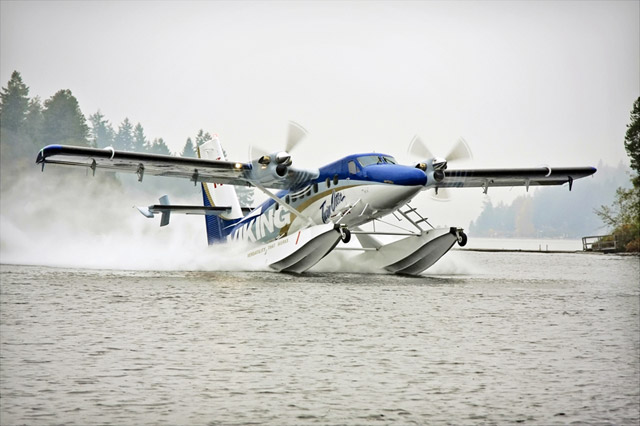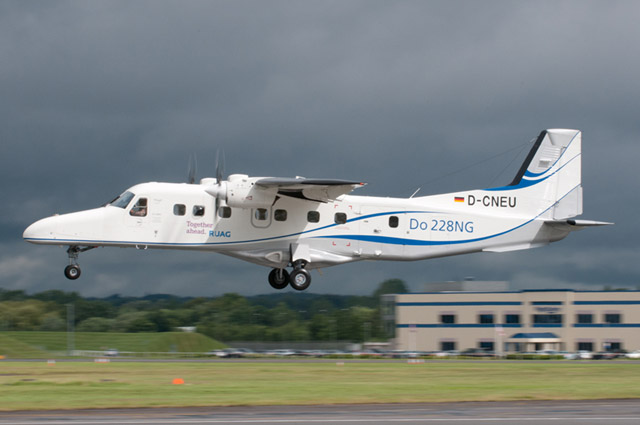Viking Air's courageous decision in 2007 to relaunch the de Havilland Canada DHC-6 Twin Otter has been justified with several recent orders, which have brought the order backlog of the new DHC-6 Twin Otter Series 400 to over C$400 million ($410 million) through to 2014.
Early in 2012, Twin Otters were ordered by customers in Turkey, Nigeria, Chile, Peru, Panama and Tahiti. Further contracts were placed at the Farnborough air show, including the first from China, with Hainan-based Meiya Air signing for five float-equipped versions. Repeat orders from Switzerland's Zimex Aviation and Florida-based Loch Ard Otters, the largest non-military operator of the 19-seat aircraft, further consolidate this success story. Sales have been made to 16 countries and include 25% of the Guardian 400 variant, developed for special mission and government operations in medium-range maritime patrol and critical infrastructure support. A total of 17 aircraft have been delivered.
 |
|---|
| AirSpace/flyvertosset The order backlog of the new DHC-6 Twin Otter Series 400 now stands at over C$400 million ($410 million) |
Viking Air has also been granted type certification from the US Federal Aviation Administration and the Russian Interstate Aviation Committee Aviation Register (IACAR). The IACAR certification came just weeks before the scheduled delivery of the first two aircraft ordered by Russian launch customer and Viking representative, Vityaz Avia Corporation of Moscow.
The most significant of the 800 changes developed to modernise the original production model included the integration of the Honeywell Primus Apex avionics suite, upgraded Pratt & Whitney Canada PT6A-34 engines and the use of composite materials.
The company is also considering resurrecting the 44-seater DHC-5 Buffalo, which made its first flight in 1964. The relaunched DHC-5NG Buffalo would include a host of refinements, including Pratt & Whitney PW150 engines, a six-blade composite propeller and a modern cockpit. Some 29 of the 126 aircraft produced remain in service with military and civil customers.
Sales of the modernised Dornier 228NG, based on the Dornier 228-212 and being offered by RUAG Aviation, started slowly and are down to a mere trickle. The last announced contract was in July 2011 for two aircraft for the Bangladesh navy, which will be used for maritime patrol and rescue missions along the country's coastline from 2013. A total of eight aircraft have been sold to other customers in Norway, Japan and Germany. RUAG is looking for an order from Malaysia for five maritime patrol aircraft, in conjunction with the setting up of a local MRO facility.
Despite the sluggish sales performance, the company's confidence in its product was affirmed in June 2012, with the official opening of the modernised assembly hall at Oberpfaffenhofen near Munich. The final assembly of the 228NG will take place in the hall, together with the conversions into various types of special missions, using the most up-to-date sensor technology.
The main enhancements over its predecessor are the upgraded Honeywell TPE331-10 engines with five-blade composite propellers, glass cockpit and new aerodynamics. RUAG targets a production rate of eight to 12 228NGs per year to meet a forecast of 300-plus aircraft over 20 years.
 |
|---|
| apgphoto/AirSpace RUAG is targetting a production rate of eight to 12 228NGs per year |
The CASA 212-400 received a fillip in July, when local carrier Merpati Nusantara placed an order for 20 aircraft with state-owned Dirgantara Indonesia, also known as Indonesian Aerospace. The 24-seat high-wing turboprop has uprated 925shp (690kW) Honeywell TPE331-12JR-701C engines, increased payload and upgraded avionics. Former president BJ Habibie is said to be set to revive the long-delayed N250 50-seat regional turboprop aircraft project, which is to be developed and manufactured by Regio Aviasi Industri.
Australia's GippsAero, the aircraft manufacturing division of India's Mahindra Aerospace, has flown the GA10, the 10-seat stretched version of the popular GA8 Airvan. The type is expected to receive certification in February 2013. Plans are also progressing for the 18-seat GA18, a relaunch of the GAF N24 Nomad, for which production ceased in 1985. GippsAero is using a New Zealand-registered N24A as a developmental aircraft and hopes to fly the re-engineered type by the end of 2012, with service introduction by 2014. The GA18 will have upgraded Rolls-Royce 250-B17F/1 turboprop engines, new Hartzell propellers, a glass cockpit, weight-saving measures, reduced maintenance requirements and aerodynamic refinements. Construction of a new dedicated hangar for the GA18 began in April 2012.
Source: Flight International




















